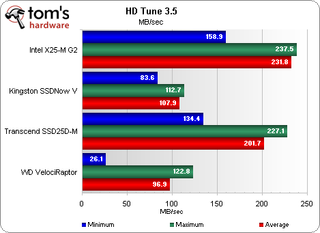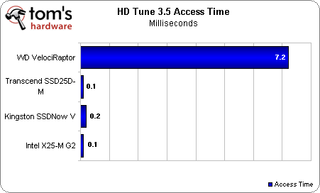Can Bargain SSDs Give Windows A Quantum Performance Leap?
Benchmark Results: HD Tune
In real life, maximum throughput rarely matters. Minimum throughput can matter in some applications, such as video streaming, so it’s important to keep one eye on those numbers. The most important number is average sustained throughput, because this gives the best indication of how quickly your transfers will move over a prolonged period.




In these graphs, you can see the traditional declining curve of the hard drive compared to the relative flat line of the SSD. You also get some sense for how jittery read performance is across the media. Smoother is better. You don’t want to see the drive spend much time in throughput valleys.
Here’s our composite look at the results:

Again, it’s the red line, the sustained average, that matters most here. Intel beats the field once more, and the VelociRaptor comes in last, albeit still breaking the 100 MB/s mark. Considering that the Transcend is a prior-generation drive behind the Intel, it puts in a surprisingly strong showing here. This leaves Kingston and WD to duke it out. With the Kingston approaching half of the VelociRaptor’s price, low-end SSD remains pretty compelling if you don’t care about capacity. I did find it interesting that the SSDNow registered a slight blip of 0.02 ms on the access time radar. Apparently, not all SSD’s a “immune” to seek times.

Stay on the Cutting Edge
Join the experts who read Tom's Hardware for the inside track on enthusiast PC tech news — and have for over 25 years. We'll send breaking news and in-depth reviews of CPUs, GPUs, AI, maker hardware and more straight to your inbox.
Current page: Benchmark Results: HD Tune
Prev Page Benchmark Results: CrystalDiskMark Next Page Benchmark Results: PCMark Vantage-
timbo Dual drive ftw. It especially gives me an important advantage in loading mp maps faster: every second counts in getting to advantageous spots first; it can & does change the outcome of who wins.Reply -
I love how they neglect to include Linux, Unix and Mac. I guess that makes us just less important. By the way I'm pretty sure a SSD would make Ubuntu pretty snappy as well.Reply
-
zebow2002 Linux, Unix and Mac have a combined market share of 30%, wich makes them less important. Great article, can't wait for my Intel G2.Reply -
johnbilicki Two 64GB SSD's in RAID0 is more then enough for most users when a second RAID or bare drive is presumed. The main issue is still the cost per GB at $2-2.5 a GB I'm not knocking any one over even if it halves my boot and application time.Reply
Also in general please stop making socket 1156 like it's the best thing in town because Intel has made it clear that it's a mainstream socket and they will not be getting more then four cores ever; I am only saying this since as an upgrader I hate to see other people presume socket 1156 has a good upgrade path which it doesn't unless Intel changes it's mind and the last time I checked the upgrader's best friend is AMD (good motherboards/chipsets for under $400, unlocked multipliers for under a grand, unlocked cores, etc). -
xrodney I am using now 128GB patriot torx SSD as boot drive (only OS and few apps there leaving half drive not used) and rest apps and media having on 1.5TB 7200rpm drive.Reply
I was really thinking for 3-4 months before jumping on SSD but glad I did. Just 13 min to fully install W7, 15-18 seconds to desktop, 5-8 seconds to shutdown (5 no app running, 8 with loads of them started) and apps starting 3-8 times faster then with regular hdd.
Same as author 1st time booting to OS on SSD almost fell of chair as I was expecting to be it faster but not that much (3.5min boot time before) -
haplo602 wow ... I ma living on an ancient 40GB PATA drive at home. windows and linux and data. I really do not get how your boot drive can be 200GB of application only.Reply
a nice 64GB SSD drive would be just fine for all my needs.
one remark, can you include fakeraid (mobo implemented raid) raid1 configuration tests ? -
xrodney haplo602wow ... I ma living on an ancient 40GB PATA drive at home. windows and linux and data. I really do not get how your boot drive can be 200GB of application only.a nice 64GB SSD drive would be just fine for all my needs.one remark, can you include fakeraid (mobo implemented raid) raid1 configuration tests ?Its not that hard windows 7 64bit alone take like 15GB add hybernation file few apps and you are way over 40GB, some apps or games can have even more then 10GB (AoC have 30GB+).Reply -
Otus Looks like I might need to get a small SSD soon. Since my Ubuntu root (OS+apps) partition has just 4GB of data, I should be more than OK with a 64GB drive. Unfortunately stuffing Windows in there would be almost impossible.Reply -
xrodney SnarkI get the boot drive on desktop angle... but what about laptop installations?On laptop you should even see more performance boost as 2.5" drives they use are usually considerably slower then on desktop. Also you would get rid of possibility damaging disk when dropping your notebook as SSDs have no moving parts.Reply
Most Popular

